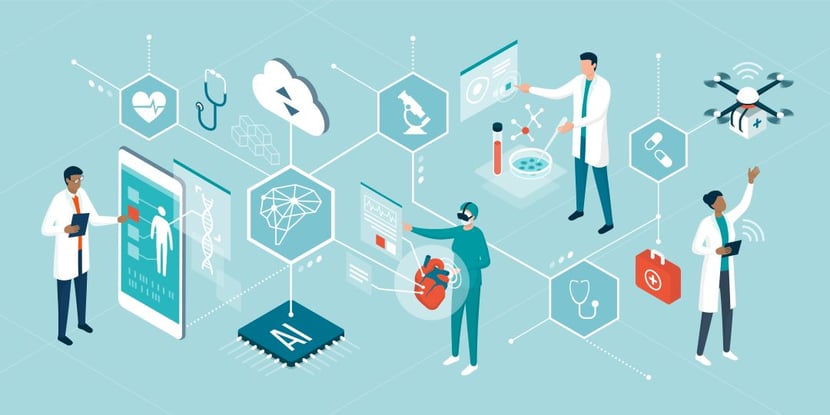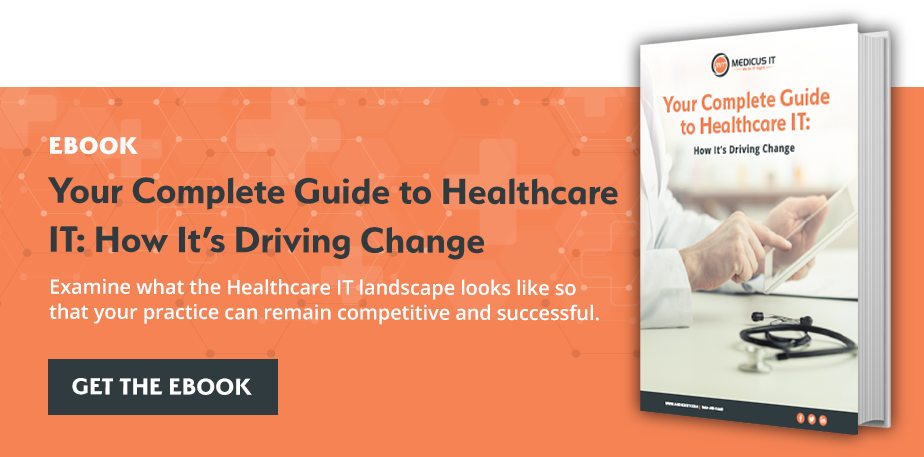6 Healthcare Information Technology Trends to Watch Heading Into 2021

Healthcare information technology adoption continues to provide support for healthcare organizations that are under pressure to deliver care as the challenges of the COVID-19 pandemic evolve. Provider stress and burnout, maintenance of revenue cycle performance, and lowering administrative burden are among the common challenges magnified by the pandemic. As we approach the end of the year, concerns with patient satisfaction and communication will compound issues for healthcare practices of all sizes.
In a blog from earlier in the year covering healthcare IT trends, we dove into significant updates and developments regarding the importance of cybersecurity, telehealth, and 3-D manufacturing of personal protective equipment. As we approach the end of 2020, practices are looking to lean on such healthcare information technology and other solutions to more effectively address the needs of patients due to the concurrent threat of seasonal influenza and the COVID-19 epidemic.
Here are six of the most significant emerging healthcare IT trends to watch.
1. Telehealth adoption as a foundation for improving patient experience and COVID-19 safety
Telehealth has played a pivotal role during the COVID-19 pandemic for many healthcare organizations. Telehealth adoption allows providers to proactively screen patients for COVID-19 symptoms, deliver acute care for patients without an in-person visit, and help manage in-person patient volume for nurses and providers, among other benefits.
Telehealth usage is likely to become an even more important platform for practices for many reasons, including remote patient access and multi-point care coordination. As an example, an mHealthIntelligence article discusses the use of a "teletriage" platform in which providers can diagnose a patient's symptoms, coordinate a care management plan, and effectively triage patients as their conditions develop. Analysis of the platform suggests that it can also help to reduce the need for emergency department transports and safely address barriers to healthcare access.
2. Filling in missed patient appointments with smarter telehealth and telemedicine
Healthcare providers that implemented or overhauled their telehealth platform after the federal government eased restrictions found one major issue: many patients were forgoing scheduled telehealth screenings or appointments.
When patients miss their telehealth appointments, it can create an enormous administrative backlog for healthcare organizations. Missed appointments require providers to clear calendars, creating many other headaches. It also leads to confusion for patients awaiting their telehealth sessions.
The good news is that there is an emergence of smarter telehealth platforms that make it easier to update these missed appointments on the practice side while providing more availability for patients. A Healthcare Financial Management Association (HFMA) report on expected consumerism patterns found that specific solutions can add convenience to patient bookings and telehealth management with auto-updates, real-time scheduling, and other key features.
Here's just one example identified by HFMA: "Inova, based in Falls Church, Va., is one of several systems that allow patients to see physicians' schedules in real time and jump into a slot that has opened up because another patient canceled. Consumers can access schedules and make appointments online or via a mobile app. While residents in the Washington, D.C., metropolitan area wait, on average, more than 17 days for a medical appointment, the typical appointment made through Inova's online access occurs within 24 hours because patients can see cancellations and no-shows."
3. COVID-19 screening automation and digital COVID-19 form management to help ease provider burden, improve triage
COVID-19 has contributed to increased provider burnout and stress due to the influx of patients, the danger of treating patients during a pandemic, and the potentially long hours associated with addressing patient confusion due to the ever-changing health guidelines. Healthcare information technology has rapidly adapted to help providers address these issues head-on.
COVID-19 screening automation is turning into a major assist for healthcare organizations that are performing contact tracing and aiming to minimize risks in their practices. A research case highlighted by EHR Intelligence notes that electronic health record (EHR) optimization focused on updating healthcare systems and prioritizing screening forms at the point of patient entry are already being implemented by healthcare organizations.
Screening automation for COVID-19 is a major need by healthcare practices since the influx of patients in the autumn and winter seasons are going to increase provider burden. Unifying EHR systems is an effective way to initiate automated screenings that can then link to telehealth systems and other IT platforms as well as deliver other information technology benefits in healthcare delivery.
4. Further emergence of chatbots and automated customer service systems
Providers that need to effectively limit their time spent answering frequently asked questions about COVID-19 are increasingly relying on chatbot and automated tech solutions. As an Indiana University study notes, chatbots and automated customer service technology represent great solutions to resolve COVID-19 questions for a growing number of patients: "Chatbots are scalable, so they can meet an unexpected surge in demand when there is a shortage of qualified human agents." The authors of this study also explain that chatbots "can provide round-the-clock service at a low operational cost" — important information technology benefits in healthcare.
Chatbots and automated text messaging updates are useful, but care should be taken to ensure your organization uses only HIPAA-compliant solutions to help reduce the likelihood of a potential breach in consumers' protected health data.
5. Value-based care solutions driving patient satisfaction and care coordination
Healthcare organizations that are investing in solutions to support value-based initiatives may have a leg up on similar-sized competitors. Practices that are able to provide consumer experiences that emphasize the cornerstone concepts of value-based care are more likely to retain patients and build greater patient counts.
Strategies and technologies that will have the most success in helping practices build value-based patient experiences include telehealth onboarding, patient-facing interactivity, and detailed communication.
A NEJM Catalyst column analyzes some of the key components of patient engagement platforms that can help provide value-driven care solutions: "Support for patients new to virtual technology should be part of the communication process. To ensure a smoother transition, we have created a three-stage approach: patient portal electronic messaging with instructions for downloading and using our telehealth platform, a second review by the staff who schedule telehealth visits, and finally a dry run by the medical assistant preparing the patient for a visit in the virtual exam room."
Additionally, the writers of the column emphasized that tone, meaningful interactions, warmth, and positive attitude are necessary to pair with these technologies to ensure a successful patient experience.
6. Value-based patient participation and meaningful data collection will power value-based experiences
A recent PatientEngagementHIT article highlighted a Deloitte Insights report that a growing number of patients are now more likely to share their information with healthcare organizations. The researchers stressed that patient groups are likely to only share information if they believe it is used to create better healthcare experiences. As the article notes, "Seventy-one percent of patients are currently willing to share their health data with their payers, 73% with their providers or health systems, and 53% with a leading national health system. This is compared to 65, 71, and 47 percent of patients, respectively, who said the same before the pandemic."
Clinical leaders are primed to gather meaningful consumer-facing data, instead of clinical insights, that can help provide more competitive and value-driven care for their patients. Practices investing in solutions that can collect this data in a HIPAA-compliant platform while also implementing the information captured into key business decision making may gain a competitive edge when vying for new patient groups.

